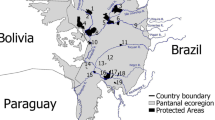Abstract
In semi-arid lands with warm climates, aridity is a real hazard, with the threat of desertification because of greater precipitation variability and prolonged droughts. Aridity indices can be used to identify areas prone to desertification. The present study aimed to analyse the spatial distribution of aridity in Extremadura, southwestern Spain, using three indices: the De Martonne aridity index (I DM), the Pinna combinative index (I P), and the Food and Agriculture Organization (FAO) aridity index (I F). Temperature, precipitation, and evapotranspiration data from 90 weather stations located throughout Extremadura and 27 along boundaries with at least 30-year length (within the 1980–2011 period) were used to compute each index at each station. The statistical properties of each aridity index were assessed, and later, they were mapped by means of an integrated geographic information system (GIS) and a multivariate geostatistical (regression-kriging) algorithm in which exhaustive secondary information on elevation was incorporated. Annual and seasonal I DM and I F, and annual I P-kriged maps were generated. According to annual I DM, the semi-arid and Mediterranean conditions are predominant in the region, covering about 70 % of the territory, while about 94 % of the areas are classified as dry and semi-dry Mediterranean based on annual I P and about 86 % are classified as semi-arid and dry categories based on annual I F. The most vulnerable to aridity are the natural regions located to the west, the south, and the southeast of Extremadura, especially during summer, when arid conditions are found across the region. Although the three aridity indices were highly correlated, displaying similar spatial patterns, I DM was preferred because it can better discriminate different climate conditions in Extremadura.





Similar content being viewed by others
References
Alexandersson H, Moberg A (1997) Homogenization of Swedish temperature data. Part I: homogeneity test for linear trends. Int J Climatol 17:25–34
Almarza C (1984) Fichas hídricas normalizadas y otros parámetros hidrometeorológicos, tomo II. National Meteorological Institute INM, Madrid
American Meteorological Society (2013) Glossary of meteorology. http://glossary.ametsoc.org/wiki/Main_Page. Accessed 15 March 2015
Baltas E (2007) Spatial distribution of climatic indices in northern Greece. Meteorol Appl 14:69–78
Bannayan M, Sanjani S, Alizadeh A, Sadeghi Lotfabadi S, Mohamadian A (2010) Association between climate indices, aridity index, and rainfed crop yield in northeast of Iran. Field Crop Res 118:105–114
Costa AC, Soares A (2012) Local spatiotemporal dynamics of a simple aridity index in a region susceptible to desertification. J Arid Environ 87:8–18
Croitoru АЕ, Piticar А, Imbroane АМ, Burada DC (2013) Spatiotemporal distribution of aridity indices based on temperature and precipitation in the extra-Carpathian regions of Romania. Theor Appl Climatol 112:597–607
Deniz A, Toros H, Incecik S (2011) Spatial variations of climate indices in Turkey. Int J Climatol 31:394–403
Goovaerts P (1997) Geostatistics for natural resources evaluation. Oxford University Press, New York
Goovaerts P (1999) Using elevation to aid the geostatistical mapping of rainfall erosivity. Catena 34(3–4):227–242
Hargreaves GH, Samani ZA (1985) Reference crop evapotranspiration from temperature. Applied Eng in Agric 1(2):96–99
Hrnjak I, Lukić T, Gavrilov MB, Marković SB, Unkašević M, Tošić I (2014) Aridity in Vojvodina, Serbia. Theor Appl Climatol 115:323–332
Hurrell JW, Van Loon H (1997) Decadal variations in climate associated with the North Atlantic Oscillation. Clim Chang 36:301–326
IPCC (2007) Climate change 2007: mitigation. Contribution of Working Group III to the fourth assessment report of the Intergovernmental Panel on Climate Change. Cambridge University Press, Cambridge
Moral FJ (2010) Comparison of different geostatistical approaches to map climate variables: application to precipitation. Int J Climatol 30:620–631
Nastos PT, Politi N, Kapsomenakis J (2013) Spatial and temporal variability of the aridity index in Greece. Atmos Res 119:140–152
Odeh I, McBratney A, Chittleborough D (1994) Spatial prediction of soil properties from landform attributes derived from a digital elevation model. Geoderma 63(3–4):197–214
Odeh I, McBratney A, Chittleborough D (1995) Further results on prediction of soil properties from terrain attributes: heterotopic cokriging and regression-kriging. Geoderma 67(3–4):215–226
Oliver JE (2005) The encyclopedia of climatology. Springer, New York
Roig FA, Barriopedro D, García-Herrera R, Patón-Dominguez D, Monge S (2009) North Atlantic Oscillation signatures in western Iberian tree-rings. Geogr Ann Series A: Phys Geogr 91(2):141–157
Shahid S (2010) Spatio-temporal variation of aridity and dry period in term of irrigation demand in Bangladesh. American-Eurasian J Agric Environ Sci 7(4):386–396
Simón N, Montes F, Díaz-Pinés E, Benavides R, Roig S, Rubio A (2012) Spatial distribution of the soil organic carbon pool in a Holm oak dehesa in Spain. Plant Soil 1–2:537–549
Tsakiris G, Spiliotis M (2010) Planning against long term water scarcity: a fuzzy multicriteria approach. Water Resour Manag 25(4):1103–1129
Vanderlinden K, Giráldez JV, Van Meirvenne M (2004) Assessing reference evapotranspiration by the Hargreaves method in southern Spain. J Irrig Drain Eng 130(3):184–191
World Meteorological Organization (1967) A note on climatological normals (Technical note 84, WMO-208)
Acknowledgments
The authors thank the Gobierno de Extremadura for financing this work through grants to the research groups in Alcántara (TIC008) and Ingeniería Aplicada en Hortofruticultura y Jardinería (TPR009), both co-financed by European FEDER funds. The authors are also very grateful to the reviewers of this paper for providing constructive comments which have contributed to improve the final version.
Author information
Authors and Affiliations
Corresponding author
Rights and permissions
About this article
Cite this article
Moral, F.J., Rebollo, F.J., Paniagua, L.L. et al. Spatial distribution and comparison of aridity indices in Extremadura, southwestern Spain. Theor Appl Climatol 126, 801–814 (2016). https://doi.org/10.1007/s00704-015-1615-7
Received:
Accepted:
Published:
Issue Date:
DOI: https://doi.org/10.1007/s00704-015-1615-7




